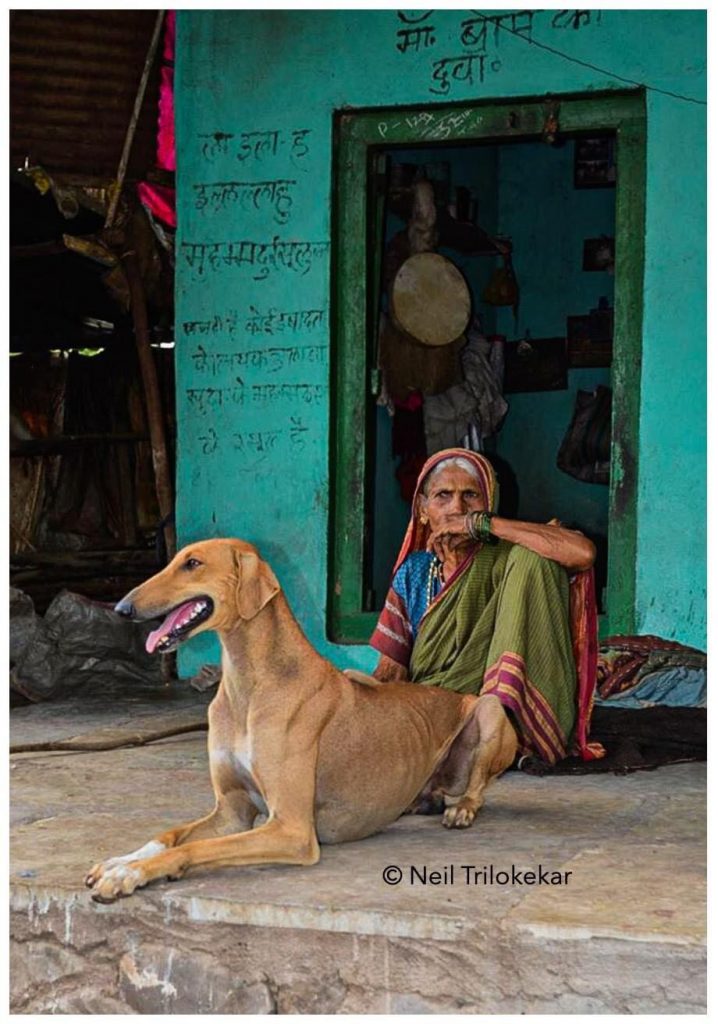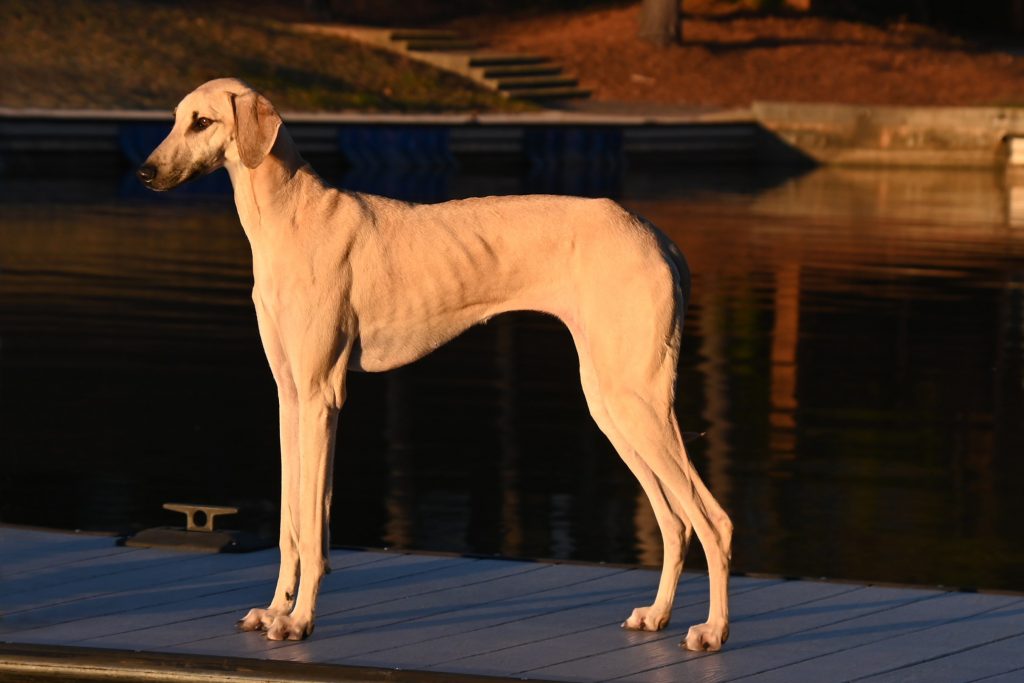422 – Exploring the Caravan Hounds of India
Exploring the Caravan Hounds of India
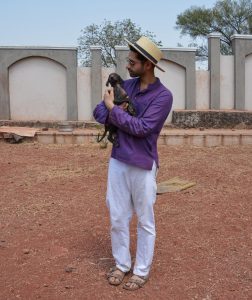 Neil Trilokekar (in photo with Caravan Hound puppy) returns for part two of this fascinating conversation with host Laura Reeves. The Caravan Hounds story is equal parts intrigue and investigative work through the mists of time, with a frisson of danger and a large helping of reverence for the common man.
Neil Trilokekar (in photo with Caravan Hound puppy) returns for part two of this fascinating conversation with host Laura Reeves. The Caravan Hounds story is equal parts intrigue and investigative work through the mists of time, with a frisson of danger and a large helping of reverence for the common man.
“First and foremost it’s a hunting dog,” Trilokekar said. “They hunt largely for hare and fox. Fox ’cause it’s a vermin and hare for food. In the old days, they would also take blackbuck which is type of gazelle, but that doesn’t really happen these days. So it’s a hunting dog, but it also is general alarm around the property. They are not aggressive. They’re not supposed to be super guardy or aggressive.
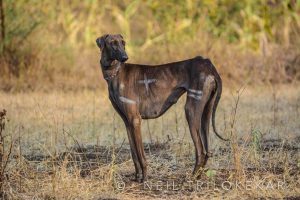 “(They are a) typical sighthound. Reserved, kind of cat-ish in their mannerisms. Personality wise, they are reserved like most Asiatic sighthounds. Most of them, they’re raised in a very rough manner, the ones that live in villages. But they still end up being very easy-going dogs. They know how to interact with the world. I’m very impressed with their characters.
“(They are a) typical sighthound. Reserved, kind of cat-ish in their mannerisms. Personality wise, they are reserved like most Asiatic sighthounds. Most of them, they’re raised in a very rough manner, the ones that live in villages. But they still end up being very easy-going dogs. They know how to interact with the world. I’m very impressed with their characters.
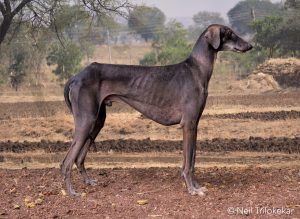 “(The Caravan Hound is) a very ‘dry’ dog. Lean dry musculature. Minimalistic in design, if you think about it that way. Very square or even slightly shorter than they are tall. Very deep chested with a really good tuck up. Not a very long loin, it’s a fairly moderate loin. The top line is fairly level more like an Afghan type top lines. Fairly level or there might be a very slight incline from the Withers up to the hip bones, not sloping down from the Withers sloping slight incline and the hip bones are prominent. Angulation is very moderate. They have very refined head. There’s two basic head types in the breed, but even what they call the more moderate head is a very refined head to begin with.
“(The Caravan Hound is) a very ‘dry’ dog. Lean dry musculature. Minimalistic in design, if you think about it that way. Very square or even slightly shorter than they are tall. Very deep chested with a really good tuck up. Not a very long loin, it’s a fairly moderate loin. The top line is fairly level more like an Afghan type top lines. Fairly level or there might be a very slight incline from the Withers up to the hip bones, not sloping down from the Withers sloping slight incline and the hip bones are prominent. Angulation is very moderate. They have very refined head. There’s two basic head types in the breed, but even what they call the more moderate head is a very refined head to begin with.
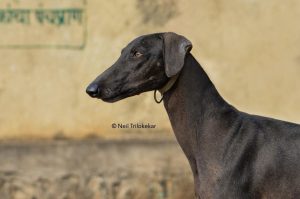 “Thin skin. The coat is a very unique coat. Nearly the only breed that I’ve felt the coat on which is kind of the same is some Shar Pei have a similar coat that they call a horse coat. That really hard bristly hair. I think some of the Chongqing Dogs might have a similar coat too. It’s very sparse. It’s almost hairless on the undersides and it looks glossy when you look at it from afar like it gleams but you touch it and it’s got like a bristly harsh feel to it. It’s a very short coat like you can see the skin through the coat. That’s definitely a very unique and prized characteristic of the breed.
“Thin skin. The coat is a very unique coat. Nearly the only breed that I’ve felt the coat on which is kind of the same is some Shar Pei have a similar coat that they call a horse coat. That really hard bristly hair. I think some of the Chongqing Dogs might have a similar coat too. It’s very sparse. It’s almost hairless on the undersides and it looks glossy when you look at it from afar like it gleams but you touch it and it’s got like a bristly harsh feel to it. It’s a very short coat like you can see the skin through the coat. That’s definitely a very unique and prized characteristic of the breed.
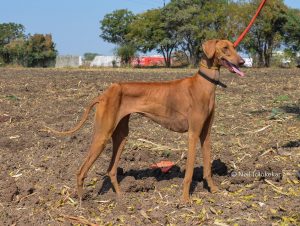 “Colours, they are usually very drab colours so they blend in with the land over which they work. They work over black cotton soil largely and so you get a lot of blacks, you get a lot of seals, shades of seal and also some of the dogs work over red soil so you get Reds and fawns and occasionally get a grey. Not blue, not a dilute like a grey, grey. Generally, a lot of old hunters and breeders, village people, they do not accept brindle and they do not accept parti colours, ’cause those are thought to have been brought in with Greyhound influence. There is not high incidence of feathered caravan hounds. Out of all the people I know and they had a meeting of 50 different people that have known the breed for years and years there was two people that have seen a feathered caravan hound born.”
“Colours, they are usually very drab colours so they blend in with the land over which they work. They work over black cotton soil largely and so you get a lot of blacks, you get a lot of seals, shades of seal and also some of the dogs work over red soil so you get Reds and fawns and occasionally get a grey. Not blue, not a dilute like a grey, grey. Generally, a lot of old hunters and breeders, village people, they do not accept brindle and they do not accept parti colours, ’cause those are thought to have been brought in with Greyhound influence. There is not high incidence of feathered caravan hounds. Out of all the people I know and they had a meeting of 50 different people that have known the breed for years and years there was two people that have seen a feathered caravan hound born.”
420 – Living History on the Silk Road
Living History on the Silk Road
Asiatic Sighthounds: Landrace to Distinct Breeds
Dedicated dog enthusiast and researcher Neil Trilokekar joins host Laura Reeves on the fascinating topic of Asiatic Sighthounds and their development from the landrace dogs of the Silk Trail over the Millenia.
Listeners may remember Trilokekar as part of our panel discussion of “new” exhibitors. This extended conversation touches on his personal
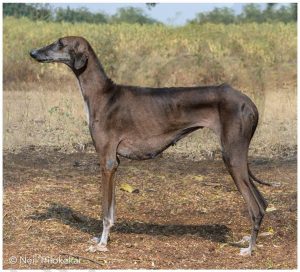
Caravan Hound from India. Photo credit: Neil Trilokekar
journey searching for authentic Caravan Hounds in his homeland.
The recent news of researchers nailing down the DNA of some sled dogs as a landrace, prompted the opportunity to dig into the endlessly intricate history of the elegant dogs of Central Asia. Additional DNA studies gather more information on the evolutionary development of landraces and the breeds that follow.
Landraces in dogs are defined as “dog or any livestock animal has been bred without a formal registry, although their breeders may have kept written or informal pedigrees of their animals.” These are distinguished from dog breeds which have breed standards, breed clubs and registries. Trilokekar expands on this concept in relation to the breeds about which he is passionate.
“My understanding of the concept of landrace as it relates specifically to Asiatic sighthounds, which is what I’m most familiar with,” Trilokekar said, “is that this type of dog which we could refer to something similar to saluki, probably originated in Mesopotamia or somewhere in Central Asia at one point. Then just through the natural course of human history kind of spread out to various parts of Asia, and in some cases North Africa as well, and evolved through selection by the local populace or the demands of climate and terrain and the local game into different breeds or types however you choose to see it.
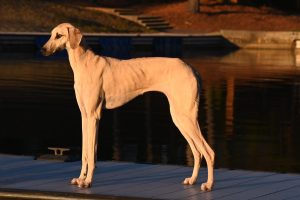
Sloughi from North Africa. Photo courtesy Erika Wyatt
“…let us presume this Asiatic sighthound type originated in Mesopotamia and from there spread into Afghanistan and became the type of dog we now refer to as an Afghan hound. They needed more hair because it was cold, and a slightly different structure to work in different terrain. … and spread out to North Africa, where it became the Sloughi.
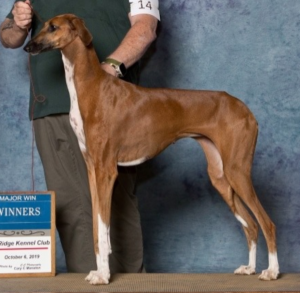
Azawakh from Central Africa. Photo courtesty Patrick Guilfoyle.
“So this is my understanding of what a landrace is. Something that occurs naturally because of human history more than someone sitting down and, for example like Louis Doberman saying I’m going to create history. I think it varies depending on the location, on the population. The Tuareg bred their dogs (Azawakh) to resemble camels, which they value above all else, so therefore you have the standing rectangle shape. That’s an active thing versus the passive. The population’s like this is the ideal of beauty for them so they are going to create dogs that resemble the camel, whereas I would
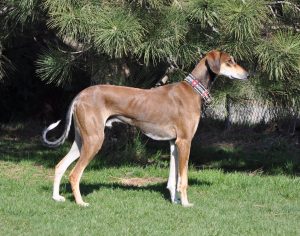
Saluki (smooth). Photo credit Kathy Jones.
imagine the Bedouin that is a more passive role because they are going solely on bringing dinner in.”
Watch this space for part two of this detailed and passionate conversation, continuing with the Caravan Hounds in India.

